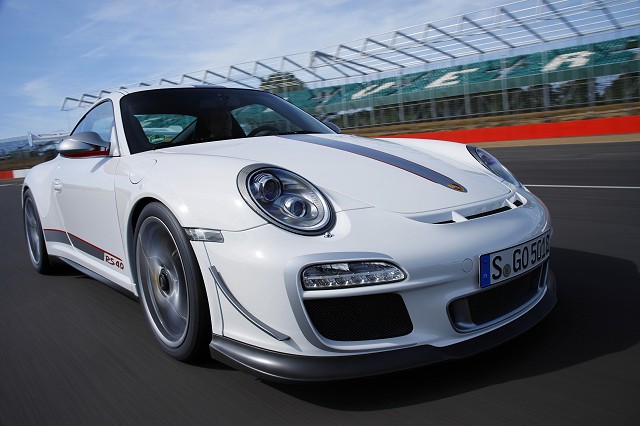When: June 2011
Where: Reading, England
What: 2011 Porsche 911 GT3 RS 4.0
Occasion: International first drive
Overall rating: 5/5
Porsche adds RSR 4.0-litre power to its RS road car to produce the most intense, exciting and involving 911 you can buy. If you're one of the lucky 600, that is.
Pricing: €230,000 (estimated imported price based on £128,466 in UK)
Engine: 4.0-litre flat-six
Transmission: Six-speed manual, rear-wheel drive
Body style: two-door coupé
Rivals: Ferrari 458 Italia, Lamborghini Gallardo, Caterham R500
CO2 emissions: 326g/km (Band G, €2,100 per annum)
Combined consumption: 13.8 litres/100km (20.5mpg)
Top speed: 310km/h (193mph)
0-100km/h: 3.9 seconds
Power: 500hp at 8,250rpm
Torque: 460Nm at 5,000rpm
In the metal 5/5
It might have its roots in racing, but the optional decals can dominate the looks of the 911 GT3. We'd do without - with the possible exception of the RS 4.0 badging and lower side sill stickers.
After all, the 4.0 is all about function; there's nothing superfluous, with every exterior change there for a reason. There's a nine-degree alteration in the angle of attack on the rear spoiler (creating 190kg of downforce), which necessitates the use of 'flics' on the sides of the front bumper to counter the rear's additional downforce. The lower splitter has been tweaked too, while the wings and bonnet are now made of carbon fibre and the rear window and side rear windows are polycarbonate to save weight. There's that magic RS word, weight, the 4.0 shedding around 10kg further to tip the scales at 1,360kg - with a full tank of fuel.
Driving it 5/5
RS models are all about fine balance mixed with incredible pace, and in truth the standard GT3 RS isn't lacking in either. In typical Porsche fashion though the RS 4.0 takes an already brilliant package and finesses it. It's not the engine that you notice first, even though it's more muscular in its mid-range and seemingly endless in its quest to eat up revs; it's actually the ride.
As a racing refugee you might expect it to be utterly uncompromising, but even with rose-jointed lower rear mounts at the back it's surprisingly compliant on our poorly surfaced B-roads. It's undeniably firm, but it retains remarkable control, maintaining its trajectory doggedly at its easily achieved speed. It's the fine feel on offer that makes this possible, the steering in particular delivering such pure response to input and clear information as to the front wheels' direction and available grip that makes the RS so involving to drive.
There's mild push-on understeer in tighter bends, but its stance is largely neutral at sane road speeds. It's possible to use the 4.0-litre's grunt to mobilise the rear, with the Sport setting allowing enough slip to be enjoyed before reigning it all in. The badge is all about the engine though, and the changes are obvious on the road. There's more power (50hp), but it's the additional torque that defines the 4.0-litre flat-six. It's surprising the difference it has made: it's faster, yet easier, a touch less frenetic, meaning you don't have to be quite so busy with the sweet-shifting six-speed manual gearbox to gain and maintain eye-widening RS pace.
The greater torque might change the engine's character, but it's still the same screamer when you're reaching for the limiter. Do so and it's ferociously quick, the need to reach for another gear coming with some big numbers on the speedometer. Third will lose you your licence and fourth will land you behind bars for a goodly while. Against the clock it'll cover the 0-100km/h sprint in 3.9 seconds - just 0.1 seconds quicker than the standard RS - and pass 200km/h in under 12 seconds.
What you get for your money 4/5
You're buying one of just 600 examples to be built. That matters, as limited number Porsches are highly sought after when new and into the future. The 4.0 RS is a bona-fide future classic with racing pedigree, though the price is a significant chunk more than the already brilliant 3.8-litre RS. You'll need to spend a bit more too, with the fade-free performing PCCB ceramic brakes and the must-have (if only for bar room bragging rights) lithium ion battery removing not just weight, but many thousands of additional pounds from your bank account.
Worth Noting
The engine's upped capacity has been achieved by increasing the stroke via a revised crankshaft. The entire engine is effectively lifted from the RSR racer, which means forged pistons and titanium connecting rods.
Summary
More power, less weight, more money, more performance. Much as you'd expect from a Porsche 911 GT3 RS model. It's a brilliant, utterly intoxicating drive, but you wouldn't feel short changed with the standard RS, unless you really like those stickers...

















































